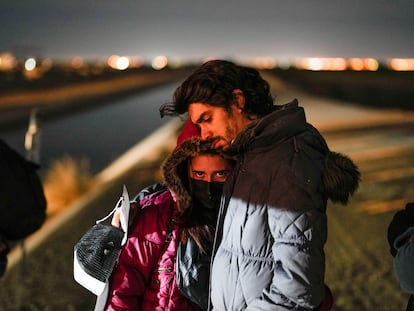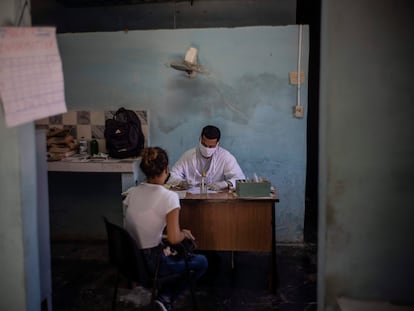The last day in the life of a bar
Mi Salsa Kitchen — one of the most popular Cuban restaurants in New York over the last couple of years — died just when it was coming alive. Mainly a space for music, it didn’t manage to make a profit
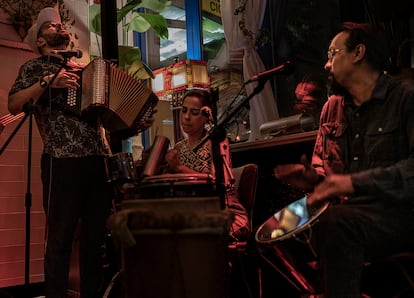

The bar eventually closed. The 13 stained-glass lamps have already been taken down from the ceiling. The staff have piled up 26 red-backed chairs and 14 wooden tables. They’ve packed the metal cutlery, white porcelain plates and black bean cans into cardboard boxes. From the office, they’ve taken down the photo of Juan Carlos Formell, ending the period of mourning for the bassist, who recently collapsed on the stage of the Lehman Center during a concert by his band, Los Van Van.
The pictures on the wall have been unscrewed, as has a sign that reads “E. Houston St., 1st Ave.” The kitchen has been dismantled and the leftover food has been packed up. A final inventory of the beverages has been conducted: two bottles of Patrón Añejo, one of Don Julio 1942, three of Cazadores Blanco, several cases of Bacardi, two of Vermouth extra dry, six of Christian Brothers and the same amount of the house vodka.
Everything that remains from Mi Salsa Kitchen will be transferred to a storage facility in the Bronx… one of those cemeteries of neoliberalism, destined for the accumulation of objects that may be deemed useful again. A lot of work has been done, friends have come to help. Spirits seem low. Some Puerto Rican salsa plays in the background… let’s say Richie Ray and Bobby Cruz.
Gustavo Martínez — the Venezuelan waiter who, until yesterday, manned the place during his shifts from eleven in the morning to six in the afternoon — rushes in to pick up his last tip.
He emits a muffled cry. “It hurts me to see this,” he sighs, cleaning his dark glasses. “Here, I wasn’t working in a restaurant. I was working with family.” Then, he walks out the front door and disappears into the crowd of Lower Manhattan.
It’s Monday, November 27. New Yorkers are recovering from Thanksgiving weekend. On the sidewalk opposite the restaurant, you can see some young women carrying the Palestinian flag, a dog-walker and fluorescent signs advertising 99-cent pizza slices that don’t really cost 99 cents. The next day, Maritza Rodríguez and Ernesto Lago — the owners of Mi Salsa Kitchen, the most popular Cuban restaurant-bar in New York over the last two years — will hand over the keys to the establishment, which is located right on the corner of Allen and Houston. The place — which is dying, just when it was coming alive — simply wasn’t profitable. It’s said that the space will be turned into a Chinese restaurant… one more on the list of 3,175 in New York. Or, on the other hand, it may turn into a burger joint (there are already 17,253 in the city). Nobody knows for sure what’s going to happen.
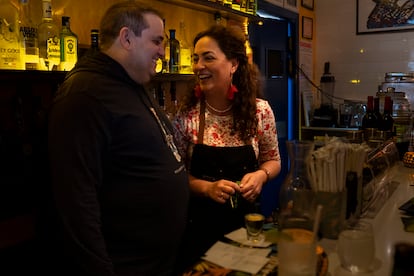
On the Sunday before the last full day, Maritza arrives at around five in the afternoon. The clothes she wears show no sign of the nearing winter: a long dress with pink flowers, comfortable sneakers and pink earrings. While Ana wraps the cutlery and Camila takes an order, Maritza sits down to eat an order of tacos.
Ana and Camila are two very young waitresses who arrived from Cuba a little over a year ago. They work at the bar. Ana is an art curator, while Camila is an artist. They became involved in the political struggle against the regime in Havana and were subsequently exiled. Maritza says that they’re the kind of people they employ: friends, those who come with a recommendation, or dissidents.
“They’re not the best workers, but I don’t care,” she shrugs, while eating her tacos. From the main door someone greets Maritza by raising their hand. She returns the greeting in the same way.
Maritza is 51-years-old. She fell in love with Ernesto 15 years ago. Before that, she worked at Amor Cubano, a restaurant located in the heart of Harlem. She smiles frequently and believes that every bar owner has to be empathetic, while also having enough discipline to spend time at the bar without drinking. “There are people who come and want to stop and listen to free music,” she explains. “I’ve had to tell them that this isn’t a park, you have to pay.”
The music — a Charanga Habanera track — remains low. The bar isn’t full, but there’s no shortage of customers at the tables. There are all kinds of clients: mostly Cubans, but also other Latinos and tourists passing through. Everything indicates that it’s going to get crowded.
On one side of Mi Salsa Kitchen, there’s a woman around the age of 70 with her dog in a small cart. “I’m not interested in people,” she says. At home, she has a 36-year-old parrot. The lady — with thick eyebrows and very long acrylic nails — doesn’t talk to just anyone. If she even remotely likes you, she might recommend vitamin D3 for your skin care, or rattle off a list of the best plastic surgeons in town. She’s a regular at the bar.
“It’s because of people like that that the bar is closing,” Martiza grumbles. “They don’t spend money.”
The elderly lady arrived from Cuba in the 1960s. She doesn’t have family here. She lives a few blocks from the bar and, every now and then, she takes a trip to Miami with her dog, where she has a second home. “Miami makes you feel old. In New York, look how I maintain myself!”
Carmelo, the kitchen assistant — a gentleman of Mexican origin in his mid-60s — goes up and down a staircase from the basement to the bar constantly, replenishing everything that time and people devour. Ernesto, 47, remains in the kitchen. “I didn’t want to come today, but how could I not? It’s the last night.”
A bell rings. Ana knows that a customer’s order is ready. Everyone knows it will be the last picadillo a la habanera, the last beef and chipotle tacos, the last pork chunks, the last black beans and the last stuffed tostones. The employees know it and the customers know it. They’re eating like it’s a mass, rather than a Sunday of partying.
It’s around seven at night. A customer in his 50s approaches the bar. With a gesture, he announces that he wants to eat. Maritza — who has already finished her tacos — interprets the gesture, like a baseball player on the field. “Congrí and dough?” she asks the customer. The client nods.
The pork dumplings were probably Mi Salsa Kitchen’s most successful dish. This is according to Alfredo Junco, the chef, who more than once left the kitchen to hit the dance floor. He believes that the secret to the food was always in the textures and flavors, as well as in the freedom that Ernesto gave him to experiment. “It’s not about cooking and that’s it… it’s about researching and discovering people’s tastes.”
Ernesto decided to open the bar in February 2020, right before New York became one of the epicenters of the Covid-19 pandemic. Around that time, more than 80,000 restaurants closed their doors in the U.S., while more than 200,000 people lost their jobs in the sector. “It was a good deal,” says Maritza. “[At the time], they charged us low rent. We were afraid, but we were also convinced that it was going to be a success.”
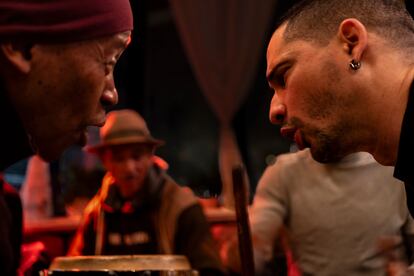
The experience, the music and the food they offered made them think that they were going to succeed among the various Cuban restaurants in the city. Ernesto hired a chef to prepare the menu, but with the condition that the fare be made strictly according to the recipes created by his mother and mother-in-law. The long menu includes traditional Cuban dishes such as fried yucca, croquettes, roast suckling pig, or congrí (black beans and rice), with prices up to more than $25. Some find it too expensive, while to others, it seems fair. Maritza says they had no other choice. “Cuban food in this city is terrible. We tried to make it like home food. But the prices, unfortunately, had to be high. We’re in New York.”
The menu also includes a list of dishes that have nothing to do with Cuban food and that show that, indeed, the customer is in New York: chicken or roast beef tacos, shrimp quesadillas, chorizo burritos, guacamole and pico de gallo. There were delicious green and red sauces prepared by Doris, a woman of Mexican descent who cooks like the Gods. Mi Salsa Kitchen served up the food that everyone looks for in New York: quick and light, in a place where everyone is always complaining about the weather.
“We changed the menu, because people began to come who weren’t just from the Cuban community. We were interested in attracting other communities,” Maritza explains. She’s now measuring the exact amounts of white rum, lemon juice, soda water, ice and mint. The customer has ordered a mojito.
Ernesto had experience as a restaurant manager when he opened Mi Salsa Kitchen. He had run another Cuban restaurant — Guantanamera — as well as a Lizarran tapas restaurant, or a Cascabel taqueria. He didn’t want to open a restaurant, but rather a Cuban takeaway. New Yorkers love to eat out and, last year, each household spent, on average, $4,004 on food away from home. But Ernesto’s idea didn’t work out and they made it a restaurant. And when they realized that, in their part of the Lower East Side, people were going out less for the food and more for the fun, they turned the place into a bar. Since then, Ernesto and Maritza have sold countless glasses of Old Cuban mojitos, margaritas, Tempranillo wine, shots of Cazamigos tequila, glasses of Tito vodka and, of course, lots of bottles of Corona, Modelo, Peroni and Brooklyn IPA beer. New Yorkers love beer, drinking about $830 a year per person, nearly double the national average.
Yuri Herrera— a Peruvian chef who works in the kitchen of a hotel about two blocks away from Mi Salsa Kitchen — came across the place while looking for a beer. “It was Sunday and I said to myself: ‘I’m going to buy beers to explore the neighborhood.’” He had arrived in town very recently and entered the store next door. He heard the salsa music. “From that day on, I became friends with Maritza and Ernesto. Now that the place is going to close, the question we all have is: ‘what are we going to do?’”
Summer nights were the best nights for Mi Salsa Kitchen, when the most beer was sold. One night, they sold over $5,300 worth of food and drinks. “That’s good, but it’s not great either,” Maritza notes. Ernesto thinks that if they had always sold that amount, they wouldn’t be closing today. On some days, their revenue was as little as $100.
When it was open, the bar was different every day of the week. On Mondays, it was closed. On Tuesday, it was quiet, with mostly gringo customers. Wednesdays tended to be tremendous, with Cuban rumba playing, bringing together the varied Latin diaspora in New York. Rumba — the Afro-Cuban rhythm — infiltrated the pagan life of New York a long time ago, in a way that it didn’t in Miami, the city of Sun and Cuban exiles.
Thursdays weren’t so great, with just a few clients swaying to the music of a Colombian cumbia group called Los Mochuelos, or the Cuban artist Danny Rojo, or downloads of Juan Carlos Formell and Danae Blanco.
“There were many beautiful moments,” Blanco recalls. She began singing in Mi Salsa Kitchen all the way back in 2020. “There are some places where you can play Cuban music, but not purely Cuban music, like here.
Some Cubans — especially Cubans over the age of 50 who live in New York City— agree that Friday was the most special of days at Mi Salsa Kitchen. Every Friday night at nine, under the dim lighting, the voice of Xiomara Laugart — one of the most important female voices in Cuba — exploded. Everyone went to see her.
Some Cubans believe that, at certain times, being in New York is like being in Havana. And not infrequently, you hear someone say that being at Mi Salsa Kitchen was like being in Cuba. What reminded them of their country wasn’t precisely a physical resemblance: it wasn’t the restaurant’s yellow walls, its blue-framed windows, or its hanging malangas. Rather, it was a feeling, the other idea of a country, the common embrace of exile. For the Cubans, Fridays were the days to meet Laugart. And, for Laugart, Fridays were the days to meet the Cubans in New York.

“It was the best thing about every Friday, how people received you,” the singer sighs. “We all had the need to feel at home. Singing in Mi Salsa Kitchen was like being in Havana, with my harpsichord, my son at the piano, people dancing, singing in chorus, as if we were in the center of the city.”
Saturdays were the days reserved for the group Los Tres del Solar. After each show, DJ Yongolailan took over the set, with a mix of Los Van Van’s most iconic songs, Bad Bunny’s summer hits, Juan Luis Guerra’s tastiest merengues, some late-night Cuban reggaeton and the most emblematic tracks by Héctor Lavoe. Everyone agrees that Mi Salsa Kitchen has been, above all, a space for music. Once, on a rumba night, the Uruguayan Jorge Drexler stopped by and grabbed the microphone and sang in chorus with the rumberos. Diego el Cigala sang on another memorable night. The singer-songwriter Descemer Bueno brought the house down with people singing his international hit, Bailando. Other performers who visited included rappers Telmary and El B, the salsa singer Alexander Abreu, several members of Los Van Van and the group Los Muñequitos de Matanzas (“the dolls of Matanzas”).
“Being on this corner is very important to me,” explained Bárbaro Ramos, a dancer with Los Muñequitos de Matanzas, when he visited the place on his 13th trip to New York. “The atmosphere [reminds me of Cuba]. And the rumba… I love the rumba.”
Sundays were typically reserved for the Guataca Trio. But on Sunday, November 26, a sign announces that the Cuban musicians won’t be playing. Rather, a last rumba will take place at Mi Salsa Kitchen. This news has been spread through social media and various WhatsApp groups. The poster displays the photo of rumbero maestro Román Díaz, a legend of percussionism and former member of the Yoruba Andabo group.
For days, it has been said that the restaurant is going to close. Nobody believes it. People wonder if it’s truly going to close. It’s true. People wonder if it’s forever. Indeed, forever. There were moments in the past when some assumed that the place had shut down, such as during the second wave of Covid, or with the increase in rent, or amid the shortage of dancers in winter. But then, suddenly, without any explanation, the place would be reborn again. In recent months, in fact, Mi Salsa Kitchen was a lively place, with loyal customers who reserved it for their nights out. Anyone passing by would think that it’s a successful spot… that it’s dying when it’s most alive.
“As a bar, it’s been successful. But monetarily, it hasn’t been,” Ernesto sighs. Over the last two years, he’s seen how several of the neighboring businesses have closed and reopened. A restaurant was converted into a churrería, a nightclub became a fast food place and a gallery was installed in a renovated pizzeria. He can think of various reasons why a Cuban bar may not be successful in New York: the limited deliveries, the lack of press, or the size of the space, which was too small.
Now that it’s just after eight at night, the bar — which is just over 750 square feet — begins to fill up with people, the last visitors to Mi Salsa Kitchen. Juan Caballero — a Cuban photographer who lives just a 10-minute walk away — has arrived. Juan is never missing, especially on Wednesdays and Fridays. Other times, when he comes home from work on the train, he sometimes just pops in to say hello. “Places like this are unrepeatable,” he laments. “Here, we’ve found company, someone to talk to, to hug.”
The rumbero — Rafael Monteagudo — enters in a hurry. “I never think that it’s the last party here,” he smiles. “Life never tells you when it’s the last time.” Meanwhile, the singer — Roger Consiglio — remains very quiet until the rumba breaks out. He appears nostalgic. He affirms that this is the only place in New York where he feels at home. “You come and have a little piece of Cuba.” The Chilean Maximo Valdés is also noticeably subdued. He will accompany Roger in singing and on the keyboard. “This is a Cuban bar, but also a Latin American one,” he notes. “A community was formed here. I’m going to miss it.”
The bar is packed when the first drums, the guagua and the cowbells sound. Everyone remains silent before the altar of the rumberos. Outside, there are rows of yellow taxis that curse Ubers, young girls in sleeveless blouses in the 40-degree cold, rats walking around the Second Avenue station, lines at the ATM, the most elegant doormen standing around in lobbies and, of course, the folks on their way to Mi Salsa Kitchen.
Enter Pupy, with his extravagant look: pointe shoes, suit and a hat. He worked as a kind of tropical host at the establishment. Pupy firmly believes that the best thing about Mi Salsa Kitchen was Pupy. “This place is special, but more special if I’m there. No Pupy, no party.” A doctor arrives with his Iranian wife: they don’t miss a single night of salsa dancing. DJ Gael Serafín also arrives — he has thrown unforgettable parties at the bar. His eyes are watery: “Right now, I’m realizing that we have no other space for Cubans to come and be together.”
There’s also Susana Vallejo, a Venezuelan who arrived one night during the pandemic and never left. “It’s a meeting place,” she emphasizes, “and we’re not going to have it anymore.” Ricardo Arnáis arrives, a Peruvian who says he hasn’t seen a place with such beautiful men and women. And, sitting in a corner, is the art curator Tata Lopera. She’s a neighbor of the bar. Two years ago, she came out of the subway and told her husband: “They’re making a new place called Mi Salsa Kitchen.” Since then, they haven’t stopped visiting.
Standing at the bar is Alejandro Cedeño, a loyal customer, who says he has many mixed feelings. Others have arrived: the old lady who once fainted, stood up and continued dancing; those who make up the long line for the bathroom; the Cuban studies teacher... There’s Armando Suárez, the poet who dances guaguancó and believes that there’s something about the bar that will never disappear: “I imagine that there will be another place where we can all meet again.”
Maritza hasn’t stopped selling drinks. It’s as if the people believe that by buying all the drinks on the last night, they can somehow save the life of the bar. When it finally closes, Maritza doesn’t know how she will spend the nights locked up at home. During the day, she plans to recover old habits that work took away from her: going to the gym, eating healthy, resting more, having time alone with Ernesto.
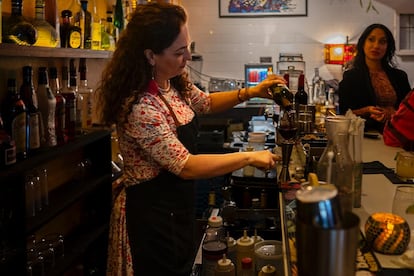
You see a lot more people arriving. They hug Maritza and thank her. It doesn’t feel like the last day of anyone’s life. Does she think it’s the last day? Maritza avoids the question: “I’ve been thinking for a month that it’s not the last month, that it’s not the last week and that tonight isn’t the last night.”
The rumba sounds increasingly louder. People barely have room to dance. Roger’s voice can be heard: “This is the last rumba we’ll sing in your home.” The people — who are now a chorus — repeat everything that Roger is singing. At one point, he shouts: “Hail Mary, it’s damn hot!” and everyone shouts back “damn hot!” under the 40 degree Manhattan sky. They’ve had to remove the tables to make space for dancing. There isn’t room for an extra soul — despite so many voices, it feels like one.
Román Díaz — the oldest rumbero — finally arrives. Everyone knows they’re watching a legend play. He arrives in a somber mood, wearing his usual glasses and beret. “All goodbyes are sad… there’s a song that says it,” he shrugs. When asked what song it is, he shakes his head in response. “I don’t know what song it is, but it exists.”
When the rumba ends (later than usual) people don’t leave, but rather remain hanging around the place. These don’t feel like the last moments of a bar: there are no rituals or words bidding farewell. People behave like they do every night. Some grab their coats and go out to smoke, before coming back in and sitting at the bar. It’s late, after two in the morning.
Maritza leaves suddenly. The police have asked for silence, a neighbor called to complain. Maritza enters and gives the order: “You have to go.” But nobody leaves. Someone breaks a bottle and Estuario appears to collect the glass. He’s a Paraguayan who has been living in the city without documents for more than 40 years. He cleans up the bar when everyone leaves. The only ones who have the privilege of getting to know Estuario are the early risers.
People stay as if they want to extend the life of the bar, but it’s time to leave. Tomorrow, the owners and their staff have to clear tables, dismantle paintings, count all the bottles that were not drunk, all the food that was not eaten, to take them to a storage room in the Bronx. Nobody cared. The bar eventually closed.
Sign up for our weekly newsletter to get more English-language news coverage from EL PAÍS USA Edition
Tu suscripción se está usando en otro dispositivo
¿Quieres añadir otro usuario a tu suscripción?
Si continúas leyendo en este dispositivo, no se podrá leer en el otro.
FlechaTu suscripción se está usando en otro dispositivo y solo puedes acceder a EL PAÍS desde un dispositivo a la vez.
Si quieres compartir tu cuenta, cambia tu suscripción a la modalidad Premium, así podrás añadir otro usuario. Cada uno accederá con su propia cuenta de email, lo que os permitirá personalizar vuestra experiencia en EL PAÍS.
¿Tienes una suscripción de empresa? Accede aquí para contratar más cuentas.
En el caso de no saber quién está usando tu cuenta, te recomendamos cambiar tu contraseña aquí.
Si decides continuar compartiendo tu cuenta, este mensaje se mostrará en tu dispositivo y en el de la otra persona que está usando tu cuenta de forma indefinida, afectando a tu experiencia de lectura. Puedes consultar aquí los términos y condiciones de la suscripción digital.
More information
Archived In
Últimas noticias
There is as much life left to discover on planet Earth as that which is already known
Dozens presumed dead, around 100 injured in fire at Swiss Alps bar during New Year’s celebration
Is porn for women different from conventional porn? We spoke to those who make it
Cartagena de Indias is sinking: What can the city do to mitigate it?
Most viewed
- Reinhard Genzel, Nobel laureate in physics: ‘One-minute videos will never give you the truth’
- David King, chemist: ‘There are scientists studying how to cool the planet; nobody should stop these experiments from happening’
- Sinaloa Cartel war is taking its toll on Los Chapitos
- Oona Chaplin: ‘I told James Cameron that I was living in a treehouse and starting a permaculture project with a friend’
- The Interoceanic Train, the Mexican alternative to the Panama Canal
